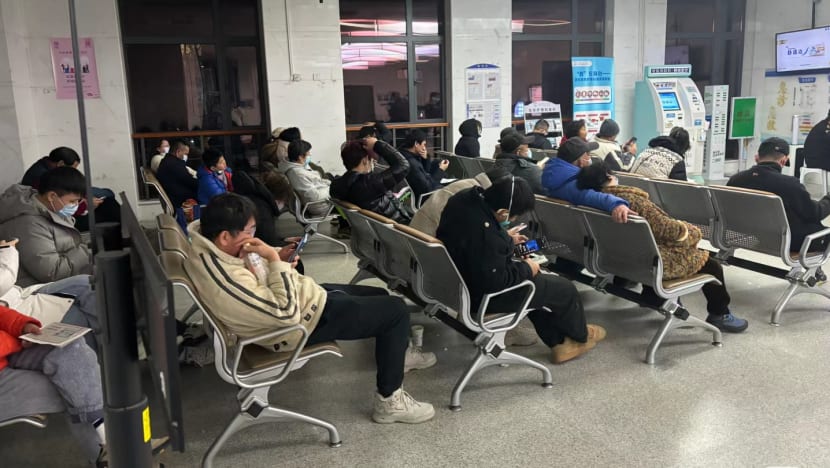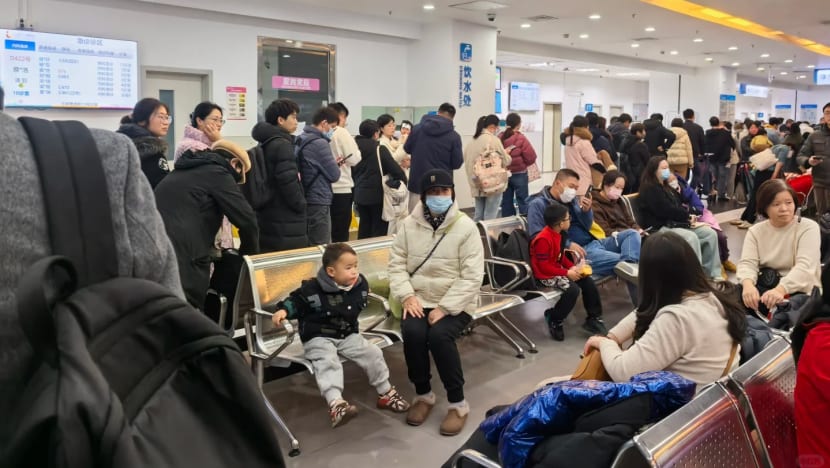CNA Explains: What is HMPV, why are cases rising in China and should you be worried?
Experts say China's rise in HMPV cases is “consistent with global patterns”. But how does the disease compare to COVID-19 and how can we protect ourselves?
.jpg?itok=GeLRQaka)
A file photo of a woman wearing a face mask and goggles walks on a street in the Jing'an district in Shanghai on Dec 21, 2022. (Photo: AFP/Hector Retamal)

This audio is generated by an AI tool.
SINGAPORE: China is seeing a surge in respiratory infections, including cases of the flu-like human metapneumovirus (HMPV) amid an annual winter spike across northern provinces, particularly among children aged 14 and below.
Without releasing figures, China’s Center for Disease Control and Prevention (CDC) on Jan 2 reported an upward trend in overall respiratory diseases recorded between Dec 23 to Dec 29.
It follows an increase in caseloads recorded in the week of Dec 16 to Dec 22, Chinese CDC officials said, announcing that they are piloting a monitoring system for “pneumonia of unknown origin” which includes establishing protocols for laboratories and disease control agencies to verify and handle cases.
Photos and videos have also circulated widely on Chinese social media sites, showing huge crowds and snaking queues forming at hospitals, clinics and medical centres.
China is still in “the season of high incidence of respiratory diseases”, the Chinese CDC said, reminding members of the public to take protective measures such as wearing masks, being up to date with vaccinations and maintaining proper hygiene practices.
“Respiratory infections tend to peak during the winter season in the northern hemisphere,” Chinese foreign ministry spokesperson Mao Ning told a press conference in Beijing on Jan 3, responding to questions about the spread of respiratory diseases and potential travel restrictions.
“The diseases appear to be less severe and spread with a smaller scale compared to the previous year,” she said.
What is HMPV?
HMPV, or human metapneumovirus, is a respiratory illness with symptoms similar to the common flu.
These include coughing, fever, nasal congestion and shortness of breath.
In severe cases, the virus can lead to complications like pneumonia or bronchitis.
“It can cause upper and lower respiratory disease in people of all ages, especially among young children, older adults and people with weakened immune systems,” the US Centers for Disease Control and Prevention (US CDC) said in a health advisory, adding that the estimated incubation period could last anytime between 3 to 6 days.
The virus is “most active” during late winter and spring in temperate climates. Young children, the elderly and those with weakened immune systems are most vulnerable, it added.
Like other respiratory diseases like COVID-19 and the flu, the HMPV virus spreads through:
- Close contact with an infected person, such as touching or shaking hands
- Droplets from sneezing and coughing
- Touching objects or surfaces that have the virus on them.
Why are cases rising?
Infectious disease experts told CNA that China's rise in cases is "consistent with global patterns", where numbers rise typically during late winter months.
The current spike coincides with China’s cold weather and low temperatures are projected to last until March.
Dr Khoo Yoong Khean from the Duke-NUS Centre for Outbreak Preparedness said HMPV infections or outbreaks are not uncommon, especially among children below the age of five.
“Infectious disease surveillance has strengthened quite a bit since COVID-19, so it’s possible we are picking up cases more easily due to better surveillance,” Dr Khoo said, adding that it is “worthwhile” to monitor these outbreaks so that “(we) can act accordingly if we notice any sudden rise in cases, or shift in transmission patterns”.
Professor Paul Tambyah, a Senior Consultant at the National University Hospital's (NUH) Division of Infectious Diseases, noted that Chinese health officials have greatly stepped up surveillance of acute respiratory infections with better diagnostics and deployment of technology.
“It is not surprising that more HMPV infections are being picked up. This does happen in China every winter on a regular basis, especially in northern China,” Prof Tambyah said.
“The bottom line is that we should not be overly concerned as there are no reports of a major public health impact from the increased detection in Northern China (but) of course, all this could change with more data,” he added.
How does it compare to COVID-19?
Public health experts have noted significant differences between both viruses, with HMPV generally less severe with a lower mortality rate.
"Amongst hospitalised patients, HMPV is not more severe (than COVID-19) and is not associated with a higher mortality rate," said Dr Shawn Vasoo, Clinical Director at the National Centre for Infectious Diseases (NCID), in response to questions by CNA.
"COVID-19 has changed since its first emergence," Dr Vasoo said. "It was initially associated with more severe disease as it was a new virus and people had no immunity to it for a start... (but now) it has become pretty much like the other common cold respiratory viruses in adults, which includes HMPV."
However, HMPV is more widespread among young children as compared to COVID-19, said Prof Tambyah.
The danger with the virus also lies in its ability to "aggravate" pre-existing health conditions like asthma, which can lead to moderate respiratory illness and sometimes require hospitalisation, Prof Tambyah added.
“Mortality is rare with HMPV,” he said, adding that HMPV-related deaths usually occur when the virus is detected with other more virulent viruses such as influenza.
But unlike COVID-19, where vaccines and antiviral treatment such as Paxlovid have been made available, there is no specific antiviral therapy to treat HMPV and currently no vaccine to prevent the disease despite the virus being discovered decades ago.
What’s happening on the ground in China?
On Chinese social media, images and videos circulated widely, showing snaking queues and crowds at hospitals and clinics in cities like Tianjin, Shanghai and Beijing.
Scores of people were seen masked up and standing outside in the cold waiting for spots.
Some parents also shared photos of huge crowds at children’s hospitals in Beijing and Chongqing.
A user on the Xiaohongshu app from Shanghai said waiting times at one local hospital averaged three hours. She decided to seek treatment at another hospital instead. “This is my first time seeing so many people at the A&E at night,” the user wrote.
Another user named Evelyn shared a photo taken late on Jan 5 of snaking lines forming at the A&E department of the Shanghai Children's Medical Center. “You can’t see the end of the line,” she wrote.
News of case numbers and infection rates are also hotly discussed by Chinese netizens, some sharing their experiences of coming down with HMPV.
“I initially thought it was a simple sore throat but then came the runny nose, headaches, dizziness and body aches,” said a Xiaohongshu user.
“HMPV isn’t like (the flu) or COVID-19 where it knocks you out in one punch,” said another user, who shared that she could only alleviate her symptoms by taking medication for the time being. “It makes you suffer little by little,” she said.


Where else is it spreading?
The World Health Organization (WHO) has not yet classified HMPV as a global health emergency but countries across Asia have been on the alert, monitoring case numbers and urging citizens to remain vigilant and practise good hygiene.
In India, one of the countries worst impacted by COVID-19, two infants tested positive in Bengaluru, the capital of the southern Karnataka state.
“It's an existing virus and (a) certain percentage of people do get affected and it is not something new,” Karnataka health minister Dinesh Gundu Rao told local reporters.
India also chaired a joint meeting on Jan 4 that was attended by WHO experts and officials from various national health and relief agencies.
“These viruses are already in circulation globally, including India. After detailed discussions and based on the currently available information, it was agreed that the situation in China is not unusual in view of the ongoing flu season,” a statement read.
Cases have been reported in Hong Kong but numbers remain low, according to city officials.
In Taiwan, health officials said they were keeping “a close watch” on the situation.
Across Southeast Asia, governments have started to issue public health advisories
Malaysia’s health ministry reported 327 cases of HMPV infections in 2024, a 45 per cent rise from 225 cases in 2023.
“The public is advised to proactively take care of their health and prevent infection to others, especially in enclosed and crowded areas. This includes those planning to travel to countries at risk,” it said in a statement released on Jan 4.
While HMPV infections have yet to be detected in Indonesia, authorities say they have started to monitor the disease’s spread in China and tightened surveillance at points of entry.
"We will continue to coordinate with the relevant parties to ensure the preventive measures are effective so this virus does not enter Indonesia," said health ministry spokeswoman Widyawati in a press statement on Saturday (Jan 4).
Vietnam on Sunday announced that it was closely monitoring the situation amid the outbreak of “virus-induced pneumonia in humans” in mainland China.
Cambodian health officials have urged people to take extra precautions, especially when travelling.
“Because the weather is not very cold (in Cambodia), HMPV is not as severe as the flu and most children have recovered,” the health ministry said.
While most cases are mild, “about 6 to 16 per cent of infected children could progress” to more severe conditions like bronchitis or pneumonia, officials said.
In Singapore, "HMPV infections occur year-round", said a spokesperson from the Ministry of Health (MOH), adding that "increased HMPV activity is typically observed during the year-end period, likely due to increased social gatherings and holiday travel".
In December last year, 5.5 per cent to 9 per cent of Acute Respiratory Infections (ARI) samples in the community were HMPV cases.
"In 2024, the weekly HMPV positivity among ARI samples in the community ranged from 0.8 per cent to 9 per cent, with a range of 5.5 per cent to 9 per cent in December," MOH said, adding that the increase is "consistent with previous years".
“HMPV has long been recognised in Singapore,” said Prof Tambyah. “In fact, it was reported as the second most common respiratory viral infection in children, after the respiratory syncytial virus (RSV), almost 20 years ago.”
How can we protect ourselves?
The uptick in HMPV cases comes five years after the world was first alerted to the emergence of the coronavirus in Wuhan, China, which went on to become a global pandemic - overwhelming hospitals, and sending countries into lockdown.
In Singapore, lessons learned from COVID-19, from better surveillance systems to good hygiene practices like washing hands thoroughly and masking up especially in crowded spaces, will serve us well, said Dr Khoo from Duke-NUS.
"The public is advised to practise good personal hygiene, especially when travelling overseas," the MOH spokesperson said.
Since most HMPV infections occur in younger children, Prof Tambyah advised families travelling with children to be mindful.
“If Singaporeans are travelling with children, they will need to pay attention to respiratory infections that appear more prolonged or more severe than usual and seek medical attention promptly.”
“Our surveillance system also is well set up to pick up cases locally if there are and we are up to date with global surveillance data of infectious diseases,” said Dr Khoo.
“If there is any hint of a more serious or widespread respiratory viral infection almost anywhere in the world, I think that we would be able to react quickly and efficiently,” said Prof Tambyah.
"Fortunately, that does not seem to be the case with HMPV."




















